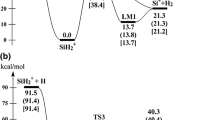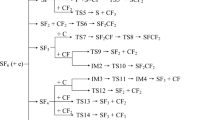Abstract
The thermal unimolecular decomposition of SiH4 + ion and its related reverse reactions, SiH3 + + H and SiH2 + + H2, have been investigated by ab initio molecular orbital and quantum statistical variational RRKM theory calculations. The potential energy surface has been calculated at different levels of theory; the results at the highest level, CCSD(T)/CBS//CCSD(T)/6-311++G(3df,2p), show that the decomposition of SiH4 + can mainly occur via a barrierless channel giving SiH2 + + H2 lying 11.8 kcal/mol above the reactant, or via a transition state forming SiH3 +···H complex to be followed by a barrierless decomposition yielding SiH3 + + H lying 23.5 kcal/mol above the reactant. Barrierless processes were calculated using the CASPT2 and CASSCF methods with the 6-311++G(3df,2p) basis set and fitted with Morse potentials. The rate constants were predicted by solving master equations based on the RRKM theory at the E,J-resolved level; the results show that the channel SiH4 + → SiH2 + + H2 is predominate under PEVCD conditions. For H- and H2-capturing by SiH3 + and SiH2 + ions, respectively, the rate constants were found to be weakly dependent on temperature at the high-pressure limit and decrease rapidly with pressure. The calculated heats of formation of the SiH +x (x = 2–4) ions are in close agreement with available thermochemical data.





Similar content being viewed by others
References
Iliescu C, Chen BT (2008) Thick and low-stress PECVD amorphous silicon for MEMS applications. J Micromech Microeng 18:015024
Iliescu C, Chen BT, Poenar DP, Lee YY (2008) PECVD amorphous silicon carbide membranes for cell culturing. Sens Actuators B 129:404–411
Iliescu C, Tay FEH, Wei J (2006) Low stress PECVD–SiNx layers at high deposition rates using high power and high frequency for MEMS applications. J Micromech Microeng 16:869–874
Matsuda A (2004) Thin-film silicon-growth process and solar cell application. Jpn J Appl Phys 43:7909–7920
Nishizaki S, Ohdaira K, Matsumura H (2009) Comparison of a-Si TFTs fabricated by Cat-CVD and PECVD methods. Thin Solid Films 517:3581–3583
Hu S, Wang Y, Wang X, Chu T, Liu X (2003) Gas-phase reactions between silane and ammonia: a theoretical study. J Phys Chem A 107:9189–9196
Jasinski JM, Becerra R, Walsh R (1995) Direct kinetic studies of silicon hydride radicals in the gas phase. Chem Rev 95:1203–1228
Ay F, Aydinli A (2004) Comparative investigation of hydrogen bonding in silicon based PECVD grown dielectrics for optical waveguides. Opt Mater 26:33–46
Liu L, Liu WG, Cao N, Cai CL (2013) Study on the performance of PECVD silicon nitride thin films. Def Technol 9:121–126
Bleecker DK, Herrebout D, Bogaerts A, Gijbels R, Descamps P (2003) One-dimensional modeling of a capacitively coupled rf plasma in silane/helium, including small concentrations of O2 and N2. J Phys D Appl Phys 36:1826–1833
Chatham H, Hils D, Robertson R, Gallagher A (1984) Total and partial electron collisional ionization cross sections for CH4, C2H6, SiH4, and Si2H6. J Chem Phys 81:1770
Kushner MJ (1992) Simulation of the gas phase processes in remote plasma activated chemical vapor deposition of silicon dielectrics using rare gas–silane–ammonia mixtures. J Appl Phys 71:4173
Perrin J, Leroy O, Bordage MC (1996) Cross-sections, rate constants and transport coefficients in silane plasma chemistry. Contrib Plasma Phys 36:3–39
Roth A, Chiussi S, Dietrich TR, Comes FJ (1990) Hydrogenated amorphous silicon by infrared multiphoton absorption with a pulsed CO2-laser. Ber Bunsen Ges Phys Chem 94:1105–1110
Raghunath P, Lin MC (2013) Ab initio chemical kinetics for SiH2 + Si2H6 and SiH3 + Si2H5 reactions and the related unimolecular decomposition of Si3H8 under a-Si:H-CVD conditions. J Phys Chem A 117:10811–10823
Wu SY, Lee YM, Wu JS, Lin MC (2014) Ab initio chemical kinetics for the unimolecular decomposition of Si2H5 radical and related reverse bimolecular reactions. Int J Quantum Chem 114:278–288
Huang WF, Chen HT, Lin MC (2013) Computational investigation of the adsorption and reactions of SiHx (x = 0–4) on TiO2 anatase (101) and rutile (110) surfaces. Int J Quantum Chem 113:1696–1708
Raghunath P, Lee YM, Wu SY, Wu JS, Lin MC (2013) Ab initio chemical kinetics for reactions of H atoms with SiHx (x = 1–3) radicals and related unimolecular decomposition processes. Int J Quantum Chem 113:1735–1746
Nguyen TN, Lin MC (2017) Ab initio chemical kinetics for SiHx reactions with Si2Hy (x = 1,2,3,4; y = 6,5,4,3; x + y = 7) under a-Si: H CVD Condition. Int J Chem Kinet 49:197–208
Varma DH, Raghunath P, Lin MC (2010) Ab initio chemical kinetics for the reaction of H atom with Si3H8. J Phys Chem A 114:3642–3648
Wu SY, Raghunath P, Wu JS, Lin MC (2010) Ab initio chemical kinetic study for reactions of H atoms with SiH4 and Si2H6: comparison of theory and experiment. J Phys Chem A 114:633–639
Nguyen TN, Lee YM, Wu JS, Lin MC (2017) Capturing H and H2 by SiH +x (x: 4) ions: comparison between Langevin and quantum statistical models. Jpn J Appl Phys 56:026101
Hess GG, Lampe FW (1966) Ionic reactions in gaseous monosilane. J Chem Phys 44:2257
Henis JMS, Stewart GW, Tripodi MK, Gaspar PP (1972) Ion–molecule reactions in silane. J Chem Phys 57:389
Krishnakumar E, Srivastava SK (1995) Ionization cross sections of silane and disilane by electron impact. Contrib Plasma Phys 35:395–404
Neuert H, Clasen H (1952) Massenspektrometrische untersuchung von SH2, SeH2, PH3, SiH4 und GeH4. Z Naturforsch 7:410–416
Berkowitz J, Greene JP, Cho H, Ruščić B (1987) Photoionization mass spectrometric studies of SiHn (n = 1–4). J Chem Phys 86:1235
Tachikawa H (2002) A full dimensional ab initio direct trajectory study on the ionization dynamics of SiH4. Phys Chem Chem Phys 4:1135–1140
Basner R, Schmidt M, Tarnovsky V, Becker K, Deutsch H (1997) Dissociative ionization of silane by electron impact. Int J Mass Spectrom Ion Process 171:83–93
Morrison JP, Traeger JC (1973) Ionization and dissociation by electron impact III. CH4 and SiH4. Int J Mass Spectrom Ion Phys 11:289–300
Potzinger P, Larnpe FW (1969) An electron impact study of ionization and dissociation of monosilane and disilane. J Phys Chem 73:3912
Paddon-Row MN, Wong SS (1987) On the structure of the SiH4 + cation and its potential energy surface for rearrangement and dissociation: an ab initio M.O. study. J Chem Soc Chem Commun 4:1585
Gordon MS (1987) Structure and stability of SiH +*4 . Chem Phys Lett 59:410–413
Power D, Brint P, Spalding T (1984) A Gaussian 80 (6-21G) study of the species SiHn (n = 1–4) and SiH +m (m = 1–5): some comments on the electron impact mass spectrum of silane. J Mol Struct Theochem 108:81–92
Caballol R, Catala JA, Problet JM (1986) Jahn-Teller distortions in XII: radical cations (X = Si, Ge, Sn). An ab initio study. Chem Phys Lett 130:278–284
Pople JA, Curtiss LA (1987) Theoretical thermochemistry. 2. Ionization energies and proton affinities of AHn species (A = C to F and Si to Cl); heats of formation of their cations. J Phys Chem 91:155–162
Wang L, He YL (2008) Halogenated silanes, radicals, and cations: theoretical predictions on ionization energies, structures and potential energy surfaces of cations, proton affinities, and enthalpies of formation. Int J Mass Spectrom 276:56–76
Ignacio EW, Schlegel HB (1990) An ab initio study of the structures and heats of formation of fluorosilanescations (SiHmF +n , m + n = 1–4). J Phys Chem 94:7439–7445
Chien SH, Li WK, Ma NL (2000) Thermochemistry of hydrochlorofluorosilanes: a gaussian-3 ab initio study. J Phys Chem A 104:11398–11402
Purvis GD III, Bartlett RJ (1982) A full coupled-cluster singles and doubles model: the inclusion of disconnected triples. J Chem Phys 76:1910–1918
Raghavachari K, Trucks GW, Pople JA, Head-Gordon M (1989) A fifth-order perturbation comparison of electron correlation theories. Chem Phys Lett 157:479–483
Pople JA, Head-Gordon M, Raghavachari K (1987) Quadratic configuration interaction—a general technique for determining electron correlation energies. J Chem Phys 87:5968–5975
Frisch MJ et al (2010) Gaussian 09, Revision C.01. Gaussian Inc., Wallingford
Woon DE, Dunning TH (1995) Gaussian basis sets for use in correlated molecular calculations. V. Core-valence basis sets for boron through neon. J Chem Phys 103:4572
Raghunath P, Nghia NT, Lin MC (2014) Ab initio chemical kinetics of key processes in the hypergolic ignition of hydrazine and nitrogen tetroxide. Adv Quantum Chem 69:253–301
Peterson KA, Woon DE, Dunning TH (1994) Benchmark calculations with correlated molecular wave functions. IV. The classical barrier height of the H + H2 → H2 + H reaction. J Chem Phys 100:7410
Wardlaw DM, Marcus RA (1988) On the statistical theory of unimolecular processes. Adv Chem Phys 70:231
Klippenstein SJ, Wagner AF, Dunbar RC, Wardlaw DM, Robertson SH (1999) VARIFLEX, Version 1.00. Argonne National Laboratory, Argonne
Baer T, Hase WL (1996) Unimolecular reactions dynamics: theory and experiment. Oxford University Press.
Fernandez-Ramos A, Miller JA, Klippenstein SJ, Truhlar DG (2006) Modeling the kinetics of bimolecular reactions. Chem Rev 106:4518–4584
Fisher ER, Armentrout PB (1990) Kinetic energy dependence of dissociative charge-transfer reactions of He+, Ne+, Ar+, Kr+, and Xe+ with silane. J Chem Phys 93:4858
Boo BH, Armentrout PB (1987) Energetics and reaction mechanisms of reactions of SiH+ + D2, SiD+ + H2, and collision induced dissociation of SiD3 +. J Phys Chem 91:5777–5781
Boo BH, Armentrout PB (1987) Reaction of silicon ion (2P) with silane (SiH4, SiD4). Heats of formation of SiHn, SiH +n (n = 1, 2, 3) and Si2H +n (n = 0, 1, 2, 3). Remarkable isotope exchange reaction involving four hydrogen shifts. J Am Chem Soc 109:3549–3559
Proft FD, Geerlings P (1996) Ab initio and density functional theory study of the Jahn Teller distortion in the silane radical cation. Chem Phys Lett 262:782–788
Author information
Authors and Affiliations
Corresponding author
Electronic supplementary material
Below is the link to the electronic supplementary material.
Rights and permissions
About this article
Cite this article
Nguyen, T.N., Lee, Y.M., Wu, J.S. et al. Ab Initio Chemical Kinetics for the Thermal Decomposition of SiH4 + Ion and Related Reverse Ion–Molecule Reactions of Interest to PECVD of a-Si:H Films. Plasma Chem Plasma Process 37, 1249–1264 (2017). https://doi.org/10.1007/s11090-017-9825-7
Received:
Accepted:
Published:
Issue Date:
DOI: https://doi.org/10.1007/s11090-017-9825-7




